
Centre of Jaina Studies Newsletter: SOAS - University of London
Nākoḍā Bhairava is a protective deity in a Jain Śvetāmbara pilgrimage site in western Rajasthan. He is extremely popular in the Śvetāmbara community, and also well known to scholars of Jainism, for his granting of boons. Conducting fieldwork in Rajasthan, however, I was struck by a different aspect of Nākoḍā Bhairava, namely his habit of possessing his devotees and communicating through the possessed subjects to those interested. In what follows I will present some of the main topics that I dealt with in my MPhil thesis on the cult of Nākoḍā Bhariava.
Nākoḍā Bhairava is located in the temple of Pārśvanātha, the main temple of Nākoḍā tīrtha. At present, his threedimensional idol is standing on the right hand of the main idol (mūl-nāyak) of Pārśvanātha, right outside the inner sanctum. This has not always been the case. According to various books and booklets on the history of Nākoḍā tīrtha, the earlier form of Nākoḍā Bhairava was aniconic (piṇḍākar). As the story goes, a lay Jain had a dream in which Nākoḍā Bhairava indicated where a hidden Jina idol was buried. The idol was recovered and installed in the temple in 1455. The aniconic idol of Nākoḍā Bhairava was simultaneously installed next to the temple entrance by the Kharatara Gaccha monk Kīrtiratnasūri.
The site was later abandoned by Jains until the Tapā Gaccha nun Sundarśrī (1859-1937) came to Nākoḍā tīrtha at the beginning of the 20th century and decided to spend the rest of her life working on its restoration. In the years that followed she travelled around gathering monetary support and inspiring people to visit the site, actively propagating the cult of Nākoḍā Bhairava. In 1934 a new idol of Nākoḍā Bhairava was fashioned on the instruction of Jain mendicants who had seen his true form (svārup) in dreams. The new idol of Nākoḍā Bhairava was installed inside the temple, next to Pārśvanātha.
The history of the cult of Nākoḍā Bhairava is thus intimately connected with Jain ascetics, who actively supported and promulgated it. Similarly the cults of other deities, such as Ghaṇṭākarṇa Mahāvīra, a protective deity akin to Nākoḍā Bhairava, were also promulgated and supported by a Jain ascetic (Cort 2001:91). In short, Jain ascetics have been central to the formation of deity cults that are concerned with fulfilling worldly desires. The argument that Jain mendicants would see non-Jain deities as unwelcome accretions to the original faith (Jaini 1991:193f.) fits poorly in the case of Nākoḍā Bhairava. Although it is not clear what the nature of Nākoḍā Bhairava and his cult was before he was installed in the Jain temple, it seems reasonable to assume that Nākoḍā Bhairava has at some point been a local deity without links to Jainism, similar to the many other Bhairavas found in Rajasthani villages.
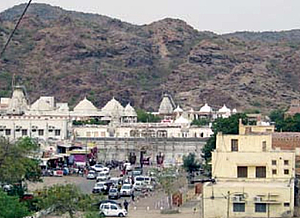
Nākoḍā tīrtha
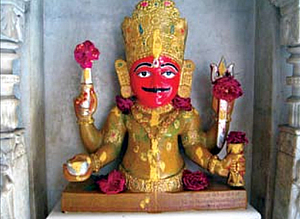
A replica of Nākoḍā Bhairava found at Prakrit Bharati Academy in Jaipur.
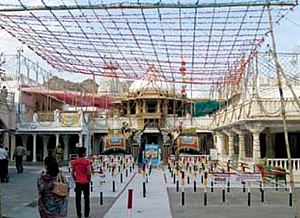
Pārśvanātha temple
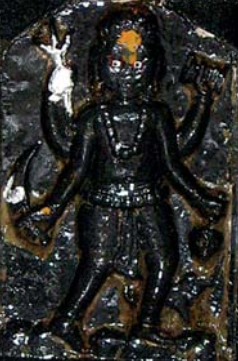
Kālā Bhairava with a skull in his lower left hand.
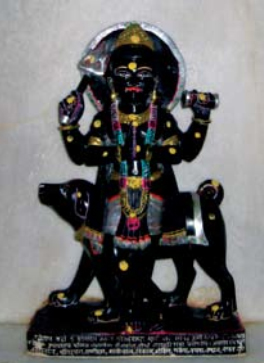
The Kālā Bhairava situated in the Dādābāṛī in Nākoḍā.
The generic name bhairava, coming from the Sanskrit root bhī, has the meanings 'frightful' and 'terrible'. In various Hindu contexts the Bhairava is often related to death and destruction. Although Nākoḍā Bhairava is primarily associated with granting boons, certain aspects of his nature retain traits that are typical of Hindu Bhairavas. He is said to have commanded black bugs to fight against Muslim attackers and he can cause accidents as a response to the disobeying of ritual rules. Such traits are problematic in the Jain context because of the demands of non-violence (ahiṃsā). It is tempting to understand them as traits that have been curtailed through processes of taming. His somewhat ambivalent nature is clearly seen in his identification as the brother of Nākoḍā Kālā Bhairava.
The Kālā Bhairava shrine in Nākoḍā has no clear marks of Jainism and is located outside the temple complex. I was surprised to see lay Jains dressed in pūjā clothes participating in his worship, and learned that his shrine is also under the Nākoḍā Trust and a part of the Jain tīrtha. Kālā Bhairava has a malevolent facial expression, holds a head skull (kapāla) in his lower left hand and apparently stands on a heap of skulls. He appears to be on the edge of what Jainism can tolerate. A sign in front of the shrine urged the worshippers not to use alcohol in their offerings.
There is, however, another Kālā Bhairava in Nākoḍā situated in the Dādābāṛī outside the temple complex. The iconography of the two Kālā Bhairavas reveals several differences. While the first Kālā Bhairava is devoid of Jain ascetics in its shrine or any obvious marks of Jainism at all, the second Kālā Bhairava is situated in a Dādābāṛī a place to worship Jain ascetics. The Dādābāṛī Kālā Bhairava does not carry a head skull. Instead, his two lower hands have their palms united in veneration. He has become a devout follower of Jain ascetics.
The history of the Jain goddess Saciyā Mātā offers an interesting parallel, I believe, to what we see in Nākoḍā. According to Jain clan histories she was tamed, or jainised, from the fierce Hindu goddess Cāmuṇḍā, into a vegetarian Jain goddess (Babb 1996:155-70). The sign in front of the Kālā Bhairava shrine urging people not to use alcohol in their offerings indicates that this has been a part of his diet. At this stage he is already somewhat tamed since he no longer needs this according to the sign, but it is in the Dādābāṛī that we see Kālā Bhairava completely jainised. Another indication of this process of taming are the kapālas. A kapālā can denote a cranium, but also simply a bowl. Both the first mentioned Kālā Bhairava and Nākoḍā Bhairava have a kapāla, but while the former has a human skull connected to his left hand, the latter is holding a cup with his right hand. When Jain mendicants had dreams in which they saw the true form of Nākoḍā Bhairava, the kapāla appeared as a bowl and not as a cranium. In this way, the Bhairavas in Nākoḍā illustrate different stages of jainisation.
Nākoḍā Bhairava's relationship to Pārśvanātha and the hierarchy between them is clear-cut according to normative Jainism: Pārśvanātha is the only truly worship-worthy.[1] Most of the Jains I spoke to stated that Pārśvanātha should be the center of attention, but they also readily admitted that many come to Nākoḍā because of the Bhairava. In front of the temple there is a large sign reminding people to always show their respects to the Jina before the Bhairava.[2] In worship we find that Nākoḍā Bhairava's āratī hymn is longer than that of Pārśvanātha and that it is sung with more gusto and devotion. While many devotees seem to pass the Jina rather hastily, prayers in front of the Bhairava are longer and more intense. The prices for performing the rituals of Nākoḍā Bhairava exceed that of Pārśvanātha. Somewhat surprisingly, a curtain is drawn before Pārśvanātha when the worship of Nākoḍā Bhairava commences. Although the implications of this do not fit well with Jain doctrine, the possibility of offending Pārśvanātha does fit well with my argument that there is a tension here between the deity and the Jina.
Both the history and contemporary expression of the cult of Nākoḍā Bhairava convinced me that it is easy to overlook the very real presence of devotional elements in Jainism because of its overtly ascetic profile. This was particularly evident in the possession cult. In my fieldwork I observed Jains that combined ascetic practices related to soteriology, such as fasting, and devotional practices, such as hymn singing and possession. The few accounts I have found of Jain possession are mostly related to negative, disease-producing spirit possession. In Nākoḍā, however, it is the Bhairava that possesses. Many people would rush to those possessed in order to touch their feet or be touched by them. In some instances the possessed will answer questions from surrounding people making it an oracular possession. It appears that this is a fairly recent development since the local sources and hymns only mention that Nākoḍā Bhairava can protect from spirit attacks, and not that he himself can possess. The widespread critique I recorded regarding the possession cult in Nākoḍā was not concerned with it being improper in a Jain temple, inconsistent with Jainism or ideals of self-control, but that many of them were faked in order to attract potential clients. This needs further investigation, but if we accept this critique it seems that whatever else a possession might be an expression of, in Nākoḍā, it can also work as an advertisement of special spiritual gifts.[3]
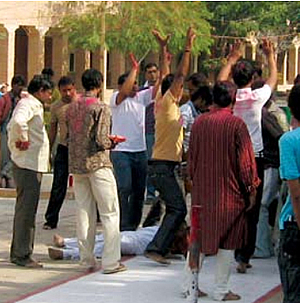
Possessed man on the ground in front of Pārśvanātha's temple. Surrounding people are singing and praising Nākoḍā Bhairava.
All photographs are by the author
Knut Aukland completed his MPhil thesis at the University of Oslo under the supervision of Torkel Brekke.
References
Babb, Lawrence A. Absent Lord: Ascetics and Kings in a Jain Ritual Culture. London: University of California Press, 1996.
Cort, John E. Jains in the World: Religious Values and Ideology in India. New York: Oxford University Press, 2001.
Jaini, Padmanabh S. 'Is There a Popular Jainism?' The Assembly of Listeners: Jains in Society. Edited by Michael Carrithers and Caroline Humphrey. Cambridge: Cambridge University Press, 1991.
 Knut Aukland
Knut Aukland